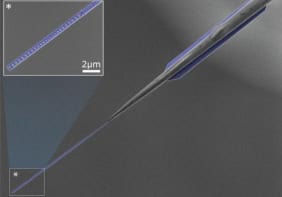
A new ink based on graphene has been used to print high-performance, transparent, thin-film transistors and interconnects. The ink was invented by researchers at the UK’s University of Cambridge, who say that the work could lead to better printed electronics, including flexible displays, solar cells and electronic paper.
Flexible electronics looks set to change the way we use technology in our everyday lives, with a wide range of devices already having been made. Inkjet printing is one of the best ways of making large amounts of plastic electronics, and a variety of components, such as transistors, photovoltaic devices, organic light-emitting diodes and displays, can be fabricated using this technique. Inkjet printing is also simple and only has a few processing steps.
The technique has been used to print thin-film transistors based on organic and semiconducting inks. However, these devices do not offer the same performance and reliability as standard silicon-based electronics.
Better transistors
Now, Andrea Ferrari and colleagues have taken an important step towards creating better devices. They have developed an ink based on graphene – sheets of carbon just one atom thick with unique electronic and mechanical properties. The ink is made by separating graphene flakes from pieces of graphite in a liquid. The process begins with treating graphite flakes in a sonic bath containing the solvent N-methylpyrrolidone for several hours. The flakes are then left to settle for a few minutes. Next, the team decants the dispersions and centrifuges the samples for an hour to filter out any flakes bigger than 1 µm across that might clog the printer nozzle.
The ink can then be used to print electronic devices such as thin-film transistors (TFTs) on a variety of substrates, including silicon dioxide and quartz. The first TFTs printed using this ink already seem to perform better than state-of-the-art inkjet-printed devices. The preliminary devices have electron mobilities of up to 95 cm2 V–1 s–1 for example. In comparison, inkjet-printed TFTs based on organic semiconducting polymers have mobilities ranging from just 0.01 to 0.5 cm2 V–1 s–1, but better on/off ratios of up to 105.
Compatible with existing technology
“Our technique is not new and the graphene ink produced should therefore be compatible with existing standard inkjet machines,” says Ferrari. “This will hopefully allow the ink to be used in existing printed electronics.”
The researchers – who report their work on the arXiv preprint server – now plan to optimize the process parameters. “We shall also be making contact with the major players in the printed-electronics industry to try and implement the ink in useful devices,” reveals Ferrari.
The work is described in arXiv:1111.4970.



